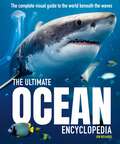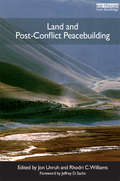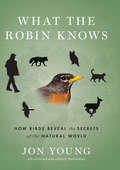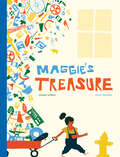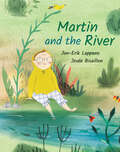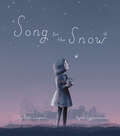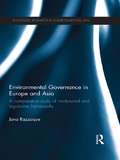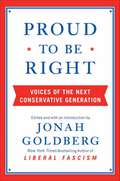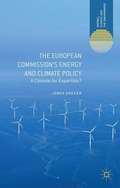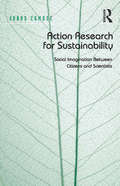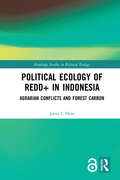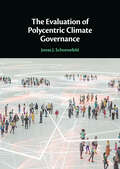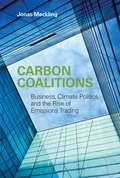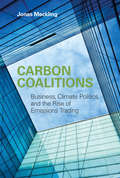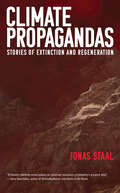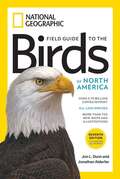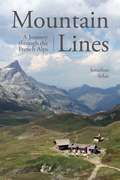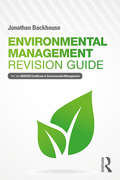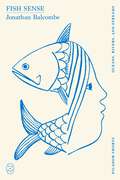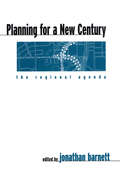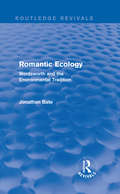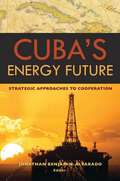- Table View
- List View
The Ultimate Ocean Encyclopedia: The complete visual guide to ocean life (Ultimate Encyclopedia #3)
by Jon RichardsThis new and unique encyclopedia is an amazing new visual guide to the planet's seas and oceans. Using amazing photography and cutting edge CG images, readers can explore every aspect of our oceans, from the submarines that explore them to the vast array of life that lives in them.Discover the plants and animals that exist in every ocean habitat, from the shore to the lowest trenches. You'll learn about sealife including crustaceans, coral, anenomes, every kind of fish, as well as mammals like sealions, dolphins and orcas, and ocean giants like the Blue Whale.Readers will also be able to see how humans have lived with the ocean for millennia, and how our actions today can doom or save our amazing oceans in the years ahead. This brand new encyclopedia is packed with stunning images that truly bring the wonder and majesty of the world's oceans to life.
Land and Post-Conflict Peacebuilding (Post-Conflict Peacebuilding and Natural Resource Management)
by Jon Unruh Rhodri C. WilliamsClaims to land and territory are often a cause of conflict, and land issues present some of the most contentious problems for post-conflict peacebuilding. Among the land-related problems that emerge during and after conflict are the exploitation of land-based resources in the absence of authority, the disintegration of property rights and institutions, the territorial effect of battlefield gains and losses, and population displacement. In the wake of violent conflict, reconstitution of a viable land-rights system is crucial: an effective post-conflict land policy can foster economic recovery, help restore the rule of law, and strengthen political stability. But the reestablishment of land ownership, land use, and access rights for individuals and communities is often complicated and problematic, and poor land policies can lead to renewed tensions. In twenty-one chapters by twenty-five authors, this book considers experiences with, and approaches to, post-conflict land issues in seventeen countries and in varied social and geographic settings. Highlighting key concepts that are important for understanding how to address land rights in the wake of armed conflict, the book provides a theoretical and practical framework for policy makers, researchers, practitioners, and students. Land and Post-Conflict Peacebuilding is part of a global initiative to identify and analyze lessons in post-conflict peacebuilding and natural resource management. The project has generated six edited books of case studies and analyses, with contributions from practitioners, policy makers, and researchers. Other books in the series address high-value resources, water, livelihoods, assessing and restoring resources, and governance.
What the Robin Knows
by Jon YoungCompanion audio files are available at www.hmhbooks.com/whattherobinknows A lifelong birder, tracker, and naturalist, Jon Young is guided in his work and teaching by three basic premises: the robin, junco, and other songbirds know everything important about their environment, be it backyard or forest; by tuning in to their vocalizations and behavior, we can acquire much of this wisdom for our own pleasure and benefit; and the birds' companion calls and warning alarms are just as important as their songs. Birds are the sentries--and our key to understanding the world beyond our front door. Unwitting humans create a zone of disturbance that scatters the wildlife. Respectful humans who heed the birds acquire an awareness that radically changes the dynamic. We are welcome in their habitat. The birds don't fly away. The larger animals don't race off. No longer hapless intruders, we now find, see, and engage the deer, the fox, the red-shouldered hawk--even the elusive, whispering wren. Deep bird language is an ancient discipline, perfected by Native peoples the world over. Finally, science is catching up. This groundbreaking book unites the indigenous knowledge, the latest research, and the author's own experience of four decades in the field to lead us toward a deeper connection to the animals and, in the end, a deeper connection to ourselves.
Maggie’s Treasure
by Jon-Erik LappanoWhen Maggie’s treasure collection grows too big to manage, she finds a creative solution. Maggie finds treasure wherever she goes. Whether it’s a button, a feather or a shiny stone, she picks it up and takes it home. At first the neighbors and city workers are grateful to Maggie for cleaning up; the mayor even gives her an award. But over time Maggie’s collection grows bigger and bigger, until it spills out of her house and garden in an unsightly mess. Her parents tell her “Enough treasure!” and eventually even Maggie realizes that something must be done. Finally, inspired by a bird outside her window, she finds a way to share her treasure that enchants and transforms the entire neighborhood. Jon-Erik Lappano and Kellen Hatanaka, winners of the Governor General’s Literary Award for Tokyo Digs a Garden, have created a stunning picture book about a child who turns her passion for collecting into a pleasure for her community. Correlates to the Common Core State Standards in English Language Arts: CCSS.ELA-LITERACY.RL.1.2 Retell stories, including key details, and demonstrate understanding of their central message or lesson.
Martin and the River
by Jon-Erik LappanoFaced with moving away from his beloved river in the country, Martin discovers it is possible to make a meaningful connection to nature in the city, too, and find ways to accept changes beyond his control. Martin loves to play by the river near his house. He watches the great blue herons and looks for crayfish and otters. He builds forts and lies in the tall grass near the water. But one day Martin’s parents tell him they have to move away, to the city. The family spend a day in the city, exploring their future home. Martin rides the subway, visits the market, explores the museum and watches a street performer, but none of the city’s charms can compare with the river. Then his parents show him a small stream running through the park, and Martin senses something familiar in the air. When moving day arrives, Martin fills a small glass jar with river water as a keepsake. And when he returns to the stream, he discovers that his connection to nature can be just as wondrous in the city. This poetic story looks at the special relationship between an imaginative child and the natural world, and explores how that connection can be nurtured and recreated in a new place. Key Text Features dialogue illustrations vignettes Correlates to the Common Core State Standards in English Language Arts: CCSS.ELA-LITERACY.RL.K.7 With prompting and support, describe the relationship between illustrations and the story in which they appear (e.g., what moment in a story an illustration depicts). CCSS.ELA-LITERACY.RL.1.2 Retell stories, including key details, and demonstrate understanding of their central message or lesson. CCSS.ELA-LITERACY.RL.1.4 Identify words and phrases in stories or poems that suggest feelings or appeal to the senses. CCSS.ELA-LITERACY.RL.1.7 Use illustrations and details in a story to describe its characters, setting, or events.
Song for the Snow
by Jon-Erik LappanoCan a long-forgotten song bring the snow back to Freya’s town? A lyrical fable from award-winning creators Jon-Erik Lappano and Byron Eggenschwiler. Freya has always loved the snow and the way it covers everything like powdered sugar. But the snow hasn’t come to her town for two winters, and she’s starting to forget what it looks and feels like. When will it be cold? When will it snow again? One day Freya finds a snow globe at the market. It plays the melody of a song that the townspeople sang for generations to call the snow home. Freya’s own grandmother used to sing it to her mother on cold winter nights. Every morning, Freya takes the snow globe outside and sings the song, but still there is no snow … until she has the idea to share the song. Soon everyone in town is singing it, and then, early one morning, the winds change. Jon-Erik Lappano and Byron Eggenschwiler have created an eloquent fable about remembering past traditions, our connection to nature and caring for a world threatened by climate change through shared effort and hope. Correlates to the Common Core State Standards in English Language Arts: CCSS.ELA-LITERACY.RL.K.1 With prompting and support, ask and answer questions about key details in a text. CCSS.ELA-LITERACY.RL.1.2 Retell stories, including key details, and demonstrate understanding of their central message or lesson. CCSS.ELA-LITERACY.RL.1.4 Identify words and phrases in stories or poems that suggest feelings or appeal to the senses. CCSS.ELA-LITERACY.RL.1.7 Use illustrations and details in a story to describe its characters, setting, or events.
Environmental Governance in Europe and Asia: A Comparative Study of Institutional and Legislative Frameworks (Routledge Research in International Environmental Law)
by Jona RazzaqueThis book looks at environmental governance in both Asia and Europe and offers a comparative analysis of the two regions in order to provide a better understanding of the concept of ‘environmental governance’ and its status in Europe and Asia. The book assesses the legislative, institutional and participatory mechanisms which affect the overall development of environmental governance, and analyses current issues, concerns and strategies in respect of environmental governance at the local, national, and international levels. The rapid changes in economic, social and political life have had an enormous impact on Asia’s ecosystems and resources. Asian countries, in the name of economic development, are following the same environmentally destructive path their European counterparts followed in the past. The key to the environmental future of these two regions lies in the evolution of the character of governance - the ensemble of social ethics, public policies and institutions which structure how state actors and the civil society interact with the environment. This book will be valuable to scholars and students of environmental politics, EU and Asian studies, public policy, environmental law, and to decision makers and policy analysts.
Iditarod Memories: 30 Years of Poster Art from the Last Great Race
by Jona Van ZyleA collection of annual posters from the official artist of the Iditarod Trail Sled Dog Race. Included are stories about how each of the first 30 posters came to be created, and the stories they tell about the race.
Proud to Be Right: Voices of the Next Conservative Generation
by Jonah GoldbergIn Proud to Be Right, Jonah Goldberg, the New York Times bestselling author of Liberal Fascism, presents voices of the next Conservative generation. A fresh and provocative collection of lively political writing from right wing writers under the age of 30, Proud to Be Right rebuts the conventional wisdom that Generation Y is a uniformly liberal demographic—and that intelligent young people today fall blindly into the Barack Obama camp.
Discourses of Global Climate Change: Apocalyptic framing and political antagonisms (Routledge Studies in Environmental Communication and Media)
by Martin Hultman Jonas AnshelmThis book examines the arguments made by political actors in the creation of antagonistic discourses on climate change. Using in-depth empirical research from Sweden, a country considered by the international political community to be a frontrunner in tackling climate change, it draws out lessons that contribute to the worldwide environmental debate. The book identifies and analyses four globally circulated discourses that call for very different action to be taken to achieve sustainability: Industrial fatalism, Green Keynesianism, Eco-socialism and Climate scepticism. Drawing on risk society and post-political theory, it elaborates concepts such as industrial modern masculinity and ecomodern utopia, exploring how it is possible to reconcile apocalyptic framing to the dominant discourse of political conservatism. This highly original and detailed study focuses on opinion leaders and the way discourses are framed in the climate change debate, making it valuable reading for students and scholars of environmental communication and media, global environmental policy, energy research and sustainability.
The European Commission�s Energy and Climate Policy
by Jonas DregerThis book offers a deep insight into the genesis and development of the European Commission's energy and climate legislation, focusing on the interplay of politics and science. How does the Commission react when confronted with knowledge? According to the author, the Commission functions as catalyst transforming knowledge into politics.
Action Research for Sustainability: Social Imagination Between Citizens and Scientists
by Jonas EgmoseHow can action research further new research orientations towards sustainability? This book, empirically situated in the field of upstream public engagement, involving local residents, researchers and practitioners in bottom-up processes deliberating on urban sustainability, answers this question by analysing processes of social learning. The book addresses the need to move towards sustainability at societal level as a democratic challenge questioning the way we live on planet earth. By conceptualising sustain-ability as an immanent and emergent ability of ecological and social life, continuously to renew itself without eroding its own foundation of existence, it argues that since sustainability cannot be invented but only supported (or eroded) by science, we need to reframe science in the role of sustaining sustain-ability. Through analyses of a three year action research programme, aiming to provide local citizens with a greater say in the future of urban sustainability research, this book shows how action research can make important methodological contributions to processes of social learning between citizens and scientists by enabling free spaces in peoples everyday life and within academia, where aspects of un-sustainability can be addressed and new imaginations of more sustainable futures emerge.
Political Ecology of REDD+ in Indonesia: Agrarian Conflicts and Forest Carbon (Routledge Studies in Political Ecology)
by Jonas I. HeinIndonesia’s commitment to reducing land-based greenhouse gas emissions significantly includes the expansion of conservation areas, but these developments are not free of conflicts. This book provides a comprehensive analysis of agrarian conflicts in the context of the implementation of REDD+ (Reducing Emissions from Deforestation and Forest Degradation) and forest carbon offsetting in Indonesia, a country where deforestation is a major issue. The author analyzes new kinds of transnational agrarian conflicts which have strong implications for global environmental justice in the REDD+ pilot province of Jambi on the island of Sumatra. The chapters cover: the rescaling of the governance of forests; privatization of conservation; and the transnational dimensions of agrarian conflicts and peasants' resistance in the context of REDD+. The book builds on an innovative conceptual approach linking political ecology, politics of scale and theories of power. It fills an important knowledge and research gap by focusing on the socially differentiated impacts of REDD+ and new forest carbon offsetting initiatives in Southeast Asia, providing a multi-scalar perspective. It is aimed at scholars in the areas of political ecology, human geography, climate change mitigation, forest and natural resource management, as well as environmental justice and agrarian studies. The Open Access version of this book, available at http://www.tandfebooks.com/doi/view/10.4324/9781351066020, has been made available under a Creative Commons Attribution-Non Commercial-No Derivatives 4.0 license.
The Evaluation of Polycentric Climate Governance
by Jonas J. SchoenefeldPolycentric climate governance holds enormous promise, but to unleash its full force, policy evaluation needs a stronger role in it. This book develops Nobel Laureate Elinor Ostrom's important work by offering fresh perspectives from cutting-edge thinking on climate governance and policy evaluation. Driven by theoretical innovation and empirical exploration, this book not only argues for a stronger connection between polycentric climate governance and practices of evaluation, but also demonstrates the key value of doing so with a real-world, empirical test in the polycentric setting of the European Union. This book offers a crucial step to take climate governance to the next level. It will be of interest to advanced students and researchers in climate governance, as well as practitioners who seek to enhance climate action, which is needed to avoid a climate catastrophe and to identify a pathway towards the 1.5° Celsius target in the Paris Agreement.
Carbon Coalitions
by Jonas MecklingOver the past decade, carbon trading has emerged as the industrialized world's primary policy response to global climate change despite considerable controversy. With carbon markets worth $144 billion in 2009, carbon trading represents the largest manifestation of the trend toward market-based environmental governance. In Carbon Coalitions, Jonas Meckling presents the first comprehensive study on the rise of carbon trading and the role business played in making this policy instrument a central pillar of global climate governance. Meckling explains how a transnational coalition of firms and a few market-oriented environmental groups actively promoted international emissions trading as a compromise policy solution in a situation of political stalemate. The coalition sidelined not only environmental groups that favored taxation and command-and-control regulation but also business interests that rejected any emissions controls. Considering the sources of business influence, Meckling emphasizes the importance of political opportunities (policy crises and norms), coalition resources (funding and legitimacy,) and political strategy (mobilizing state allies and multilevel advocacy). Meckling presents three case studies that represent milestones in the rise of carbon trading: the internationalization of emissions trading in the Kyoto Protocol (1989--2000); the creation of the EU Emissions Trading System (1998--2008); and the reemergence of emissions trading on the U. S. policy agenda (2001--2009). These cases and the theoretical framework that Meckling develops for understanding the influence of transnational business coalitions offer critical insights into the role of business in the emergence of market-based global environmental governance.
Carbon Coalitions: Business, Climate Politics, and the Rise of Emissions Trading
by Jonas MecklingAn examination of how a transnational coalition of firms and NGOs influenced the emergence of emissions trading as a central component of global climate governance.Over the past decade, carbon trading has emerged as the industrialized world's primary policy response to global climate change despite considerable controversy. With carbon markets worth $144 billion in 2009, carbon trading represents the largest manifestation of the trend toward market-based environmental governance. In Carbon Coalitions, Jonas Meckling presents the first comprehensive study on the rise of carbon trading and the role business played in making this policy instrument a central pillar of global climate governance.Meckling explains how a transnational coalition of firms and a few market-oriented environmental groups actively promoted international emissions trading as a compromise policy solution in a situation of political stalemate. The coalition sidelined not only environmental groups that favored taxation and command-and-control regulation but also business interests that rejected any emissions controls. Considering the sources of business influence, Meckling emphasizes the importance of political opportunities (policy crises and norms), coalition resources (funding and legitimacy,) and political strategy (mobilizing state allies and multilevel advocacy).Meckling presents three case studies that represent milestones in the rise of carbon trading: the internationalization of emissions trading in the Kyoto Protocol (1989–2000); the creation of the EU Emissions Trading System (1998–2008); and the reemergence of emissions trading on the U.S. policy agenda (2001–2009). These cases and the theoretical framework that Meckling develops for understanding the influence of transnational business coalitions offer critical insights into the role of business in the emergence of market-based global environmental governance.
Climate Propagandas: Stories of Extinction and Regeneration
by Jonas StaalHow climate propaganda narratives shape our (mis)understanding of the world, and how to propagate a future of repair and regeneration instead.In Climate Propagandas, Jonas Staal reveals the propaganda narratives—and the divergent realities they evoke—that shape the climate crisis in the public imaginary. It is often said that the climate crisis is a planetary one, but the devastating impact of climate crisis is distributed unequally and its related ideological positions are as vast as they are irreconcilable. A liberal might argue the crisis is the result of individual consumer behavior, whereas a libertarian sees an opportunity for geoengineering markets. A conspiracist might not believe the climate is at risk, whereas an ecofascist sees a chance to double down on the argument about who has the superior racial right to survive extinction.With an artist&’s eye and an activist&’s sense of urgency, Staal explores how these stories are told and visualized through popular film and television, internet culture, climate fiction, art, architecture, and industrial design. If life-threatening propaganda narratives have conjured our present climate catastrophe, Staal suggests, then surely stories of regeneration can propagate new planetary futures for all. His book identifies narratives that don&’t follow the path of mass extinction, but rather seek repair and regeneration of a world in crisis.
National Geographic Field Guide To The Birds Of North America, 7th Edition
by Jonathan AlderferThis fully revised edition of the best-selling North American bird field guide is the most up-to-date guide on the market. Perfect for beginning to advanced birders, it is the only book organized to match the latest American Ornithological Society taxonomy. With more than 2.75 million copies in print, this perennial bestseller is the most frequently updated of all North American bird field guides. Filled with hand-painted illustrations from top nature artists (including the ever-popular hummingbird), this latest edition is poised to become an instant must-have for every serious birder in the United States and Canada. The 7th edition includes 37 new species for a total of 1,023 species; 16 new pages allow for 250 fresh illustrations; 80 new maps; and 350 map revisions. With taxonomy revised to reflect the radical new American Ornithological Society taxonomy established in 2016, the addition of standardized banding codes, and text completely vetted by birding experts, this new edition will top of the list of birding field guides for years to come.
Mountain Lines: A Journey through the French Alps
by Jonathan ArlanA New York Times best summer travel book recommendationA nonfiction debut about an American’s solo, month-long, 400-mile walk from Lake Geneva to Nice. In the summer of 2015, Jonathan Arlan was nearing thirty. Restless, bored, and daydreaming of adventure, he comes across an image on the Internet one day: a map of the southeast corner of France with a single red line snaking south from Lake Geneva, through the jagged brown and white peaks of the Alps to the Mediterranean sea?a route more than four hundred miles long. He decides then and there to walk the whole trail solo. Lacking any outdoor experience, completely ignorant of mountains, sorely out of shape, and fighting last-minute nerves and bad weather, things get off to a rocky start. But Arlan eventually finds his mountain legs?along with a staggering variety of aches and pains?as he tramps a narrow thread of grass, dirt, and rock between cloud-collared, ice-capped peaks in the High Alps, through ancient hamlets built into hillsides, across sheep-dotted mountain pastures, and over countless cols on his way to the sea. In time, this simple, repetitive act of walking for hours each day in the remote beauty of the mountains becomes as exhilarating as it is exhausting.Mountain Lines is the stirring account of a month-long journey on foot through the French Alps and a passionate and intimate book laced with humor, wonder, and curiosity. In the tradition of trekking classics like A Short Walk in the Hindu Kush, The Snow Leopard, and Tracks, the book is a meditation on movement, solitude, adventure, and the magnetic power of the natural world.
Environmental Management Revision Guide: For the NEBOSH Certificate in Environmental Management
by Jonathan BackhouseThe Environmental Management Revision Guide: For the NEBOSH Certificate in Environmental Management is the perfect revision aid for students preparing to take their NEBOSH Certificate in Environmental Management. As well as being a handy companion volume to Brian Waters’ NEBOSH-endorsed textbook Introduction to Environmental Management, it will also serve as a useful aide-memoire for those in environmental management roles. The book aims to: Provide practical revision guidance and strategies for students Highlight the key information for each learning outcome of the current NEBOSH syllabus Give students opportunities to test their knowledge based on NEBOSH style questions and additional exercises Provide details of guidance documents publically available that students will be able to refer to. The revision guide is fully aligned to the current NEBOSH syllabus, providing complete coverage in bite-sized chunks, helping students to learn and memorise the most important topics. Throughout the book, the guide refers back to the Introduction to Environmental Management, helping students to consolidate their learning.
Fish Sense (Picador Shorts)
by Jonathan BalcombeA quirky, intimate, and eye-opening look into the ways of thinking like a fish.An extract from the much-loved modern classic on the subject of fish consciousness, What a Fish Knows.Do fishes think? Do they really have three-second memories? And can they recognize the humans who peer back at them from above the surface of the water? Jonathan Balcombe dives in among our marine cousins to explore the essential questions of how fish perceive and process the world.With his ethologist’s gift for showing us the hidden depths of questions we’ve routinely preferred to think of as simple, and his raconteur’s flair for the surprising and the curious, Balcombe takes us under the sea, through streams and estuaries, and to the other side of the aquarium glass to reveal the surprising capabilities of fishes. Balcombe upends our assumptions about fishes, portraying them not as unfeeling, dead-eyed feeding machines but as sentient, aware, social, and even Machiavellian―in other words, much like us.Using humor and a repertoire of some of the most surprising fish facts you’ve ever heard, Balcombe shakes up what you think you know about what’s going on inside the mind of these denizens of the deep.Fish Sense is part of the Picador Shorts series “Oceans, Rivers, and Streams” in which excerpts from beloved classics speak to our relationship with our water bodies, great and small.
Planning for a New Century: The Regional Agenda
by Jonathan BarnettAcross the United States, issues such as sustainability, smart growth, and livable communities are making headlines. Planning for a New Century brings together leading thinkers in the fields of planning, urban design, education, welfare, and housing to examine those issues and to consider the ways in which public policies have helped create--and can help solve--many of the problems facing our communities. Each chapter identifies issues, provides background, and offers specific policy suggestions for federal, state, and local initiatives. Topics examined include: *the relation of existing growth management policies to social equity, as well as how regional growth management measures can make new development more sustainable *how an obscure technical procedure in highway design becomes a de facto regional plan *ways in which local governments can promote environmental preservation and better-designed communities by rewriting local zoning and subdivision ordinances *why alleviating housing shortages and slum conditions has resulted in a lack of affordable housing, and how that problem can be solved *how business improvement districts can make downtowns cleaner, safer, and more welcoming to workers and visitors In addition, the book features chapters on public safety, education, and welfare reform that include proposals that will help make regional growth management easier as inner-city crime is reduced, schools are improved, and concentrations of extreme poverty are eliminated. Planning for the New Century brings together current academic research with pressing public policy concerns, and will be a useful resource for policymakers at all levels of government, for planners and architects, and for students and scholars of urban planning and design, and urban studies.
Romantic Ecology: Wordsworth and the Environmental Tradition (Routledge Revivals)
by Jonathan BateFirst published in 1991, Romantic Ecology reassesses the poetry of William Wordsworth in the context of the abiding pastoral tradition in English Literature. Jonathan Bate explores the politics of poetry and argues that contrary to critics who suggest that the Wordsworth was a reactionary who failed to represent the harsh economic reality of his native Lake District, the poet’s politics were fundamentally ‘green’. As our first truly ecological poet, Wordsworth articulated a powerful and enduring vision of human integration with nature which exercised a formative influence on later conservation movements and is of immediate relevance to great environmental issues today. Challenging the orthodoxies of new historicist criticism, Jonathan Bate sets a new agenda for the study of Romanticism in the 1990s.
Real Cowboys
by Jonathan Bean Kate HoeflerIn Kate Hoefler’s realistic and poetic picture book debut about the wide open West, the myth of rowdy, rough-riding cowboys and cowgirls is remade. A timely and multifaceted portrayal reveals a lifestyle that is as diverse as it contrary to what we've come to expect.
Cuba's Energy Future
by Jonathan Benjamin-Alvarado Vicki HuddlestonApproaching an uncertain future without Fidel Castro, and still reeling from a downturn at the end of the cold war, Cuba must act decisively to improve its economy and living conditions. One of the major challenges facing the impoverished island nation is securing access to energy resources that are sufficient to meet the needs of its revitalization and development goals. What steps can Cuba take to achieve both short- and long-term energy sustainability and self-sufficiency? In this timely analysis, Jonathan Benjamin-Alvarado and his colleagues answer that question. Cuba's Energy Future sets the geostrategic context within which Cuba is operating. The book provides an overview of the evolving relations among Caribbean states and explains why Cuba and its longtime nemesis the United States should look for ways to cooperate on developing energy resources. The possible role of oil companies is explored, as is Cuba's energy relationship with Hugo Chavez's Venezuela.The second section of Cuba's Energy Future features economic and technical appraisals, economic projections, and trends affecting Cuba's energy needs, including oil and natural gas potential, the country's antiquated electric power sector, and the role of biofuels such as sugarcane ethanol. The concluding section focuses on the conditions necessary for, and the mutual benefits of, greater cooperative engagement with the United States.Contributors: Juan A. B. Belt (Chemonics International, formerly USAID), Jonathan Benjamin-Alvarado (University of Nebraska-Omaha and University of Georgia), Amy Myers Jaffe (Rice University), Jorge R. Piñón (Florida International University), Ronald Soligo (Rice University).
